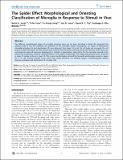| dc.contributor.author | Jonas, Rahul A. | |
| dc.contributor.author | Yuan, Ti-Fei | |
| dc.contributor.author | Liang, Yu-Xiang | |
| dc.contributor.author | Jonas, Jost B. | |
| dc.contributor.author | Tay, David K. C. | |
| dc.contributor.author | Ellis-Behnke, Rutledge | |
| dc.date.accessioned | 2012-06-27T19:00:07Z | |
| dc.date.available | 2012-06-27T19:00:07Z | |
| dc.date.issued | 2012-02 | |
| dc.date.submitted | 2011-05 | |
| dc.identifier.issn | 1932-6203 | |
| dc.identifier.uri | http://hdl.handle.net/1721.1/71226 | |
| dc.description.abstract | The different morphological stages of microglial activation have not yet been described in detail. We transected the olfactory bulb of rats and examined the activation of the microglial system histologically. Six stages of bidirectional microglial activation (A) and deactivation (R) were observed: from stage 1A to 6A, the cell body size increased, the cell process number decreased, and the cell processes retracted and thickened, orienting toward the direction of the injury site; until stage 6A, when all processes disappeared. In contrast, in deactivation stages 6R to 1R, the microglia returned to the original site exhibiting a stepwise retransformation to the original morphology. Thin highly branched processes re-formed in stage 1R, similar to those in stage 1A. This reverse transformation mirrored the forward transformation except in stages 6R to 1R: cells showed multiple nuclei which were slowly absorbed. Our findings support a morphologically defined stepwise activation and deactivation of microglia cells. | en_US |
| dc.language.iso | en_US | |
| dc.publisher | Public Library of Science | en_US |
| dc.relation.isversionof | http://dx.doi.org/10.1371/journal.pone.0030763 | en_US |
| dc.rights | Creative Commons Attribution | en_US |
| dc.rights.uri | http://creativecommons.org/licenses/by/2.5/ | en_US |
| dc.source | PLoS | en_US |
| dc.title | The Spider Effect: Morphological and Orienting Classification of Microglia in Response to Stimuli in Vivo | en_US |
| dc.type | Article | en_US |
| dc.identifier.citation | Jonas, Rahul A. et al. “The Spider Effect: Morphological and Orienting Classification of Microglia in Response to Stimuli in Vivo.” Ed. Huaibin Cai. PLoS ONE 7.2 (2012): e30763. Web. 27 June 2012. | en_US |
| dc.contributor.department | Massachusetts Institute of Technology. Department of Brain and Cognitive Sciences | en_US |
| dc.contributor.approver | Ellis-Behnke, Rutledge | |
| dc.contributor.mitauthor | Ellis-Behnke, Rutledge | |
| dc.relation.journal | PLoS ONE | en_US |
| dc.eprint.version | Final published version | en_US |
| dc.type.uri | http://purl.org/eprint/type/JournalArticle | en_US |
| eprint.status | http://purl.org/eprint/status/PeerReviewed | en_US |
| dspace.orderedauthors | Jonas, Rahul A.; Yuan, Ti-Fei; Liang, Yu-Xiang; Jonas, Jost B.; Tay, David K. C.; Ellis-Behnke, Rutledge G. | en |
| mit.license | PUBLISHER_CC | en_US |
| mit.metadata.status | Complete | |
